Images are powerful symbols. The history of the Swastika is intriguing and interesting. It is believed to be the earliest known symbol, the solar wheel, the movement and power of the sun, the origin acting upon the universe, a positive symbol before the Nazis used it. Learning the history of this powerful symbol and deconstructing its meaning will help to disempower it. Investigation of the ancient history of this symbol that is continually used to represent negative power will hopefully impact our young people into investigating symbols prior to their use due to pop culture. During the 1998 Witness and Legacy Exhibit, held at the Florida Holocaust Museum, it was clearly illustrated how many individuals had no understanding of the positive forces connected to the Swastika, only the negative modern day connotations. Investigative research is important.
Noreen B. Brand, Education Director
Florida Holocaust Museum, St. Petersburg, Florida
 |
Of the many forms of the cross, the Swastika is the most ancient. Despite the theories and speculations of students, its origin is unknown, It began before history, and is properly classified as prehistoric. Its description is as follows: The bars of the normal Swastika (Fig. 9) are straight, of equal thickness throughout, and cross each other at right angles, making four arms of equal size, length and style. Their peculiarity is that all the ends are bent at right angles and in the same direction, right or left. Prof. Max Müller makes the symbol different according as the arms are bent to the right or the left. That bent to the right demonstrates the true Swastika, that bent to the left he calls the Suavastika (Fig. 10), but he gives no authority for the statement, and the author has been unable to find, except in Burnouf, any justification for a difference of names. Professor Goodyear gives the title of "Meander" to that form of Swastika which bends two or more times (Fig. 11)." |
 |
|
Fig. 9
Normal Swastika |
Fig. 10 |

Fig. 11
Swastika Meander
The Swastika is sometimes represented with dots or points in the corners of the intersections (Fig. 12a), and occasionally the same when without bent ends (Fig. 12b), to which Zmigrodzki gives the name of Croix Swasticale. Some Swastikas have three dots placed equidistant around each of the four ends. (Fig. 12c).

Fig. 12
Croix Swasticale (Zmigrodzki)
There are several varieties possibly related to the Swastika which have been found in almost every part of the globe, and though the relation may appear slight, and at first sight difficult to trace, yet it will appear more or less intimate as the examination is pursued through its ramifications. As this paper is an investigation into and report upon facts rather than conclusions to be drawn from them, it is deemed wise to give those forms bearing even possible relations to the Swastika. Certain of them have been accepted by the author as related to the Swastika, while others have been rejected; but this rejection has been confined to cases where the known facts seemed to justify another origin for the symbol. Speculation has been avoided. (Fig. 13a, 13b, 13c, 13d).
 |
 |
|
Fig. 13a
Ogee and Spiral Swastikas Tetraskelion (four-armed) |
Fig. 13b |
 |
 |
|
Fig. 13c
Spiral and Volute (Five or many armed) |
Fig.3d
Ogee Swastika with circle |
|
Peculiar Forms of Swastika
|
|
The Swastika has been called by different names in different countries, though nearly all countries have in later years accepted the ancient Sanskrit name of Swastika; and this name is recommended as the most definite and certain, being now the most general and, indeed, almost universal. It was formerly spelled s-v-a-s-t-i-c-a and s-u-a-s-t-i-k-a, but the later spelling, both English and French, is s-w-a-s-t-i-k-a. The definition of the etymology of the word is thus given in Littre's French Dictionary:
Svastika, or Swastika, a mystic figure used by several (East) Indian sects. It was equally well known to the Brahmms as to the Buddhists. Most of the rock inscriptions in the Buddhist caverns in the west of India are preceded or followed by the holy (sacramentelle) sign of the Swastika. (Eug. Burnouf, "Le Lotus de la bonne loi." Paris, 1852, p. 625.) It was seen on the vases and pottery of Rhodes (Cyprus) and Etruria (F. Delannay. Jour. Off., Nov. 18, 1873, p. 7024, 3d Col.)
Etymology: A Sanskrit word signifying happiness, pleasure, good luck pp. 767-8.
 |
M. Eugene Burnouf speaks of a third sign of the footprint of Çakya, called Nandâvartaya, a good augury, the meaning being the "circle of fortune," which is the Swastika enclosed within a square with avenues radiating from the corners (Fig. 14). Burnouf says the above sign has many significations. It is a sacred temple or edifice, a species of labyrinth, a garden of diamonds, a chain, a golden waist or shoulder belt, and a conique with spires turning to the right. Colonel Sykes concludes that, according to the Chinese authorities Fa-hian, Soung Young, Hiuan thsang, the "Doctors of reason,'Tao-sse, or followers of the mystic cross (a Swastika) were diffused in China and India before the advent of Sakya in the sixth century B.C. (according to Chinese, Japanese, and Buddhist authorities, the eleventh century B.C.), continuing until Fa-hian's time; and that they were professors of a qualified Buddhism, which, is stated, was the universal religion of Tibet before Sakya's advent, and continued until the introduction of orthodox Buddhism in the ninth century A.D. |
|
Fig. 14
Nandâvartaya, A third sign of the footprint of Budda. |
Klaproth calls attention to the frequent mention by Fa-hian, of the Tao-sse, sectaries of mystic cross (Sanskrit Swastika), and to their existence in Central Asia and India; while he says they were diffused over the countries to the west and southwest of China, and came annually from all kingdoms and counties to adore Kassapo, Buddha's predecessor. Mr. James Burgess mentions the Tirthankaras or Jainas as being sectarians of the Mystic Cross, The Swastika.
The Cyclopædia of India (title Swastika), coinciding with Prof. Max Müller, says:
The Swastika symbol is not to be confounded with the Swastika sect in Tibet which took the symbol for its name as typical of the belief of its members. They render the Sanskrit Swastika as composed of a su "well" and asti "it is," meaning, as Professor Wilson expresses it, "so be it," and implying complete resignation under all circumstances. They claimed the Swastika of Sanskrit as the suti of Pali, and that the Swastika cross was a combination of the two symbols sutti-suti. They are rationalists, holding that the contentment of peace and mind should be the only objects of life. The sect has preserved its existence in different localities and under different names, Thirthankara, Ter, Musteg, pon, the last name meaning purity, under which a remnant are still in the farthest parts of the most eastern province of Tibet. p. 774.
 |
I explain the Jain Swastika by the following illustration (Fig. 33): The horizontal and vertical lines crossing each other at the right angles form the Greek cross, they represent spirit and matter. We add four other lines by bending to the right each arm of the cross, then three circles and the crescent, and a circle with the crescent. The idea thus symbolized is that there are four grades of existence of souls in the material universe. The first is the lowest state - Archaic or protoplasmic life. The soul evolves from that state to the next - the earth with its plant and animal life. Then follows the third stage - The Celestial. The word "celestial" is here held to mean life in other worlds than our own. All these graduations are combinations of matter and soul on different scales. The spiritual plane is that in which the soul is entirely free from the bonds of matter. In order to reach that plane, one must strive to posses the three jewels (represented by the three circles), right belief, right knowledge, right conduct. When a person has these, he will certainly go higher until he reaches the state of liberation, which is represented by the cresent. The crescent has the form of the rising moon and is always growing larger. The circle in the crescent represents the the omniscient state of the soul when it has attained full consciousness, is liberated, and lives apart from matter. Fig. 33: (1) Archaic or protoplasmic life; (2) Plant and animal life; (3) Human life; (4) Celestial life. |
|
Fig. 33
Explanation of Jain Swastika, According to Gandhi |
The interpretation, according to the jain view of the cross, has nothing to do with the combination of the male and female principle. Worship of the male and female principle, ideas based upon sex, lowest even on the emotional plane, can never rise higher than the male and female.
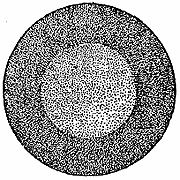 |
 |
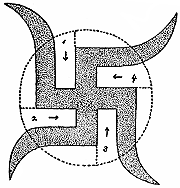 |
|
Fig. 34a
The First Stage |
Fig. 34b
The Second Stage |
Fig. 34c
The Third Stage |
|
The Foramation of the Jain Swastika
Ends turned out, typifying animal, human, and celestial life |
||
The Jains make the Swastika sign when we enter our temple of worship. This sign reminds us of the great principles represented by the three jewels and by which we are to reach the ultimate good. These symbols intensify our thoughts and make them more permanent.
Mr. Gandhi says the jains make the sign of the Swastika as frequently and deftly as the Roman Catholics make the sign of the cross. It is not confined to the temple nor to the priests or the monks. Whenever or wherever a benediction or blessing is given, the Swastika is used. Figs. 34a, b, c form a series showing how it is made. A handful of rice, meal, flour, sugar, salt, or any other substance, is spread over a circular space, say, 3 inches in diameter and 1/8" deep (Fig. 34a), then commence at the outside of the circle (Fig. 34b), on its upper or farther left hand corner and draw the finger through the meal just to the left of the center, halfway or more to the opposite or near the edge of the circle (1), then again to the right (2), then upward (3), finally to the left where it joins with the first mark (4). The ends were swept outward, the dots and the crescent put in above, and the sign is complete (Fig. 34c).
The sign of the swastika is reported in great numbers, by hundreds if not thousands, in the inscriptions on the rock walls of the Buddhist caves in India. pp. 804-5.
The Swastika has been discovered in Greece and in the islands of the Archipelago on objects of bronze and gold, but the principle vehicle was pottery; and of these the greatest number were the painted vases. (Fig. 139, Fig. 140, Fig. 141, Fig. 142) p. 839.
 |
 |
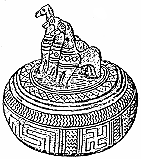 |
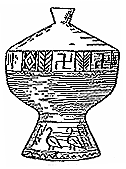 |
|
Fig. 139
Variation of the Greek Fret |
Fig. 140
Greek Geometric Vase in the Leyden Museum, with figures of Geese and Swastika in Panel, Smyrna |
Fig. 141 |
Fig. 142 |
 |
...the specimens of the Swastika found in Cyprus,..., show a Phenician influence; and according to his theory demonstrate their migration or importation. He does not specify the evidence on which he bases his assertion of Phenician influence in Cyprus, except in one or two particulars. Speaking of the specimen shown in Fig. 177 of the present paper, he says:
The design shown in Fig. 178 he describes as representing two birds in the attitude of adoration before a Swastika, all being figured on a Greek cup of the style Dipylon. Dr. Ohnefalsch-Richter adds:
He says that the Swastika as well as the "Croix cantonnée" (with points or dots), while possibly not always the equivalent of the solar disk, zigzag lightning, or the double hatchet, yet are employed together and are given the same signification, and frequently replace each other. It is in his opinion that the Swastika in Cyprus had nearly always a signification more or less religious, although it may have been used as an ornament to fill empty spaces. His interpretation of the Swastika in Cyprus is that it will signify...the storm, the lightning, the sun, the light, the seasons-...- and that its form lends itself easily to the solar disk, to the fire wheel, and to the sun chariot. In support of this, he cites a figure (Fig. 179) taken from Cesnola, in which the wheels of the chariot are decorated with four Swastikas displayed in each of the four quarters. The chief personage on the car he identifies as the god of Apollo-Resef, and the decoration on his shield represents the solar disk. he is at once the god of war and also the god of light, which identifies him with Helios. The other personage is Herakles-Mecquars, the right hand of Apollo, both of them heroes of the sun. pp. 852-3. |
|
Fig. 9
Normal Swastika |
|
 |
|
|
Fig. 9
Normal Swastika |
|
 |
|
|
Fig. 179
Chariot of Apollo-Resef |
 |
The Swastika appears to have been employed in all these epochs or stages. It was undoubtedly used during the Bronze Age, and in Italy it continued throughout the Etruscan and into the Roman and Christian periods. While it may be doubtful if any specimen of Swastika can be identified as having belonged to the Neolithic Age in Europe, there can be no doubt that it was in common use during the Bronze Age. Professor Goodyear gives it as his opinion, and in this he may be correct, that the earliest specimens of Swastika of which identification can be made are on the hut urns of Italy. These have been considered as belonging definitely to the Bronze Age in that country. Fig. 183 is a representation of one of these hut urns. It shows upon its roof several specimens of Swastika, as will be apparent from examination. There are other figures, incised an din relief. One of them is the celebrated "burning altar" mark of Dr. Schliemann. This specimen was found in the Via Apia near Rome, and is exhibited in the Vatican Museum. Similar specimens have been found in other parts of Etruria....p. 856.
|
|
Fig. 183
Hut urn in the Vatican Museum |
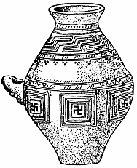 |
Figs. 185-186 represent the one handled cinerary urns peculiar to the Bronze Age in Italy. They are believed to have been contemporaneous with or immediately succeeding the hut urns just shown. The cinerary urn shown in Fig. 185 was found at Marino, near Albano, in the same locality and under the same condition as the hut urns. The original is in the Vatican Museum as was figured by Pigorini in "Archæologia, " 1869. Fig. 186 shows a one handed urn of pottery with Swastika in intaglio, placed in a band of incised squares around the body of the vessel below the shoulder. p. 857 |
 |
|
Fig. 185
Cinerary Urn with Swastikas in panels San Marino, near Albano, Italy Vatican Museum |
Fig. 185
Cinerary Urn with Swastikas incised by incised lines in Intaglio Cervetri, Italy |
The evidences of prehistoric culture have great resemblance throughout Denmark, Sweden, and Norway; so it is believed that during the prehistoric ages their peoples had the same culture, and the countries have been classed together as Scandinavia.
A bronze sword is reported...as having been found at Sæbo, Norway, with runes and a Swastika inlaid with silver. (Fig. 203)...Its runes were translated by Stephens and being read right to left, "OH THURMUTH," or "owns me Thurmuth." But on the same page he gives another sign for Thu and renders the Swastika as Odin or (W)oden....it seems to have been agreed that the Swastika stood for "blessing," "good luck," or some beneficent charm or benediction. p. 864.
 |
|
Fig. 203 |
Ludwig Müller reports the Swastika in Scotland and Ireland on the Christian tombs, associated with the Latin crosses.
A sculptured stone in Ireland (Fig. 215) shows on the face three varieties of the cross, a Greek cross in a circle, a Swastika with a square ends turned to the right, within a rectangle, and an ogee (tetraskelion) turned on the right, enclosed in a quatrefoil. pp. 868-9.
 |
|
Fig. 215 |
 |
The employment of the Swastika in France did not cease with the Bronze or Iron ages, but continued into the occupation of Gaul by the Romans. Fig. 220 represents a stone altar erected in the south of France among the Pyrenees about the time of the advent of the Romans. It has a Swastika engraved on its pedestal. p. 869. |
|
Fig. 220
Stone altar with Swastika on Pedestal France, Museum of Toulouse |
 |
Any search for the Swastika in America which omitted these Indians (Pueblo Indians) would be fatally defective, and so here it is found. Without speculating how the knowledge of the Swastika came to them, whether by independent invention or brought from distant lands, it will be enough to show its knowledge among and its use by the peoples of this country....a dance rattle made from a small gourd, ornamented in black, white and red (Fig 256). The gourd has a Swastika on each side, with the ends bent, not square, but ogee (tetraskelion)....beans, pebbles, or similar objects are inside, and the shaking of the machine makes a rattling noise which marks time for the dance. ...A large series of pottery from the various pueblos of the Southwest; these are of the painted and decorated kind common to that civilization and country. Some of these pieces bear the Swastika mark; occasionally it is found outside, occasionally inside. It is more frequently in the ogee from, similar to that on the rattle... p. 896. |
|
Fig. 256
Dance rattle made of a small gourd decorated in black, white, red. Ogee Swastika on each side. |
A Teacher's Guide to the Holocaust
Produced by the Florida Center for Instructional Technology,
College of Education, University of South Florida © 1997-2013.